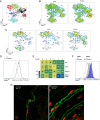Neuronal, stromal, and T-regulatory cell crosstalk in murine skeletal muscle
- PMID: 32102913
- PMCID: PMC7071852
- DOI: 10.1073/pnas.1922559117
Neuronal, stromal, and T-regulatory cell crosstalk in murine skeletal muscle
Abstract
A distinct population of Foxp3+CD4+ regulatory T (Treg) cells promotes repair of acutely or chronically injured skeletal muscle. The accumulation of these cells depends critically on interleukin (IL)-33 produced by local mesenchymal stromal cells (mSCs). An intriguing physical association among muscle nerves, IL-33+ mSCs, and Tregs has been reported, and invites a deeper exploration of this cell triumvirate. Here we evidence a striking proximity between IL-33+ muscle mSCs and both large-fiber nerve bundles and small-fiber sensory neurons; report that muscle mSCs transcribe an array of genes encoding neuropeptides, neuropeptide receptors, and other nerve-related proteins; define muscle mSC subtypes that express both IL-33 and the receptor for the calcitonin-gene-related peptide (CGRP); and demonstrate that up- or down-tuning of CGRP signals augments or diminishes, respectively, IL-33 production by muscle mSCs and later accumulation of muscle Tregs. Indeed, a single injection of CGRP induced much of the genetic program elicited in mSCs early after acute skeletal muscle injury. These findings highlight neural/stromal/immune-cell crosstalk in tissue repair, suggesting future therapeutic approaches.
Keywords: CGRP; IL-33; muscle repair; regulatory T cells; stromal cells.
Conflict of interest statement
The authors declare no competing interest.
Figures




References
Publication types
MeSH terms
Substances
Grants and funding
LinkOut - more resources
Full Text Sources
Molecular Biology Databases
Research Materials

